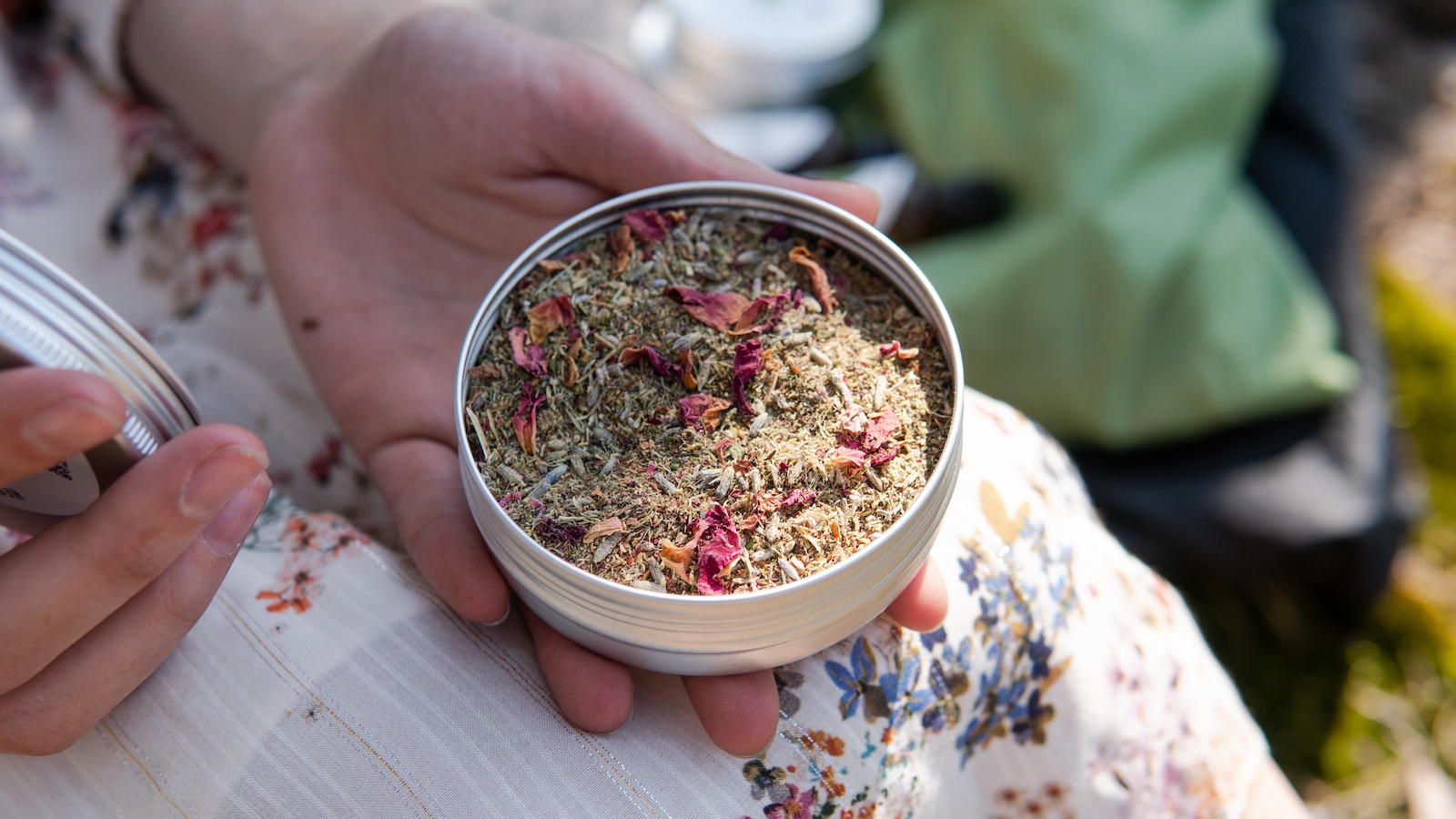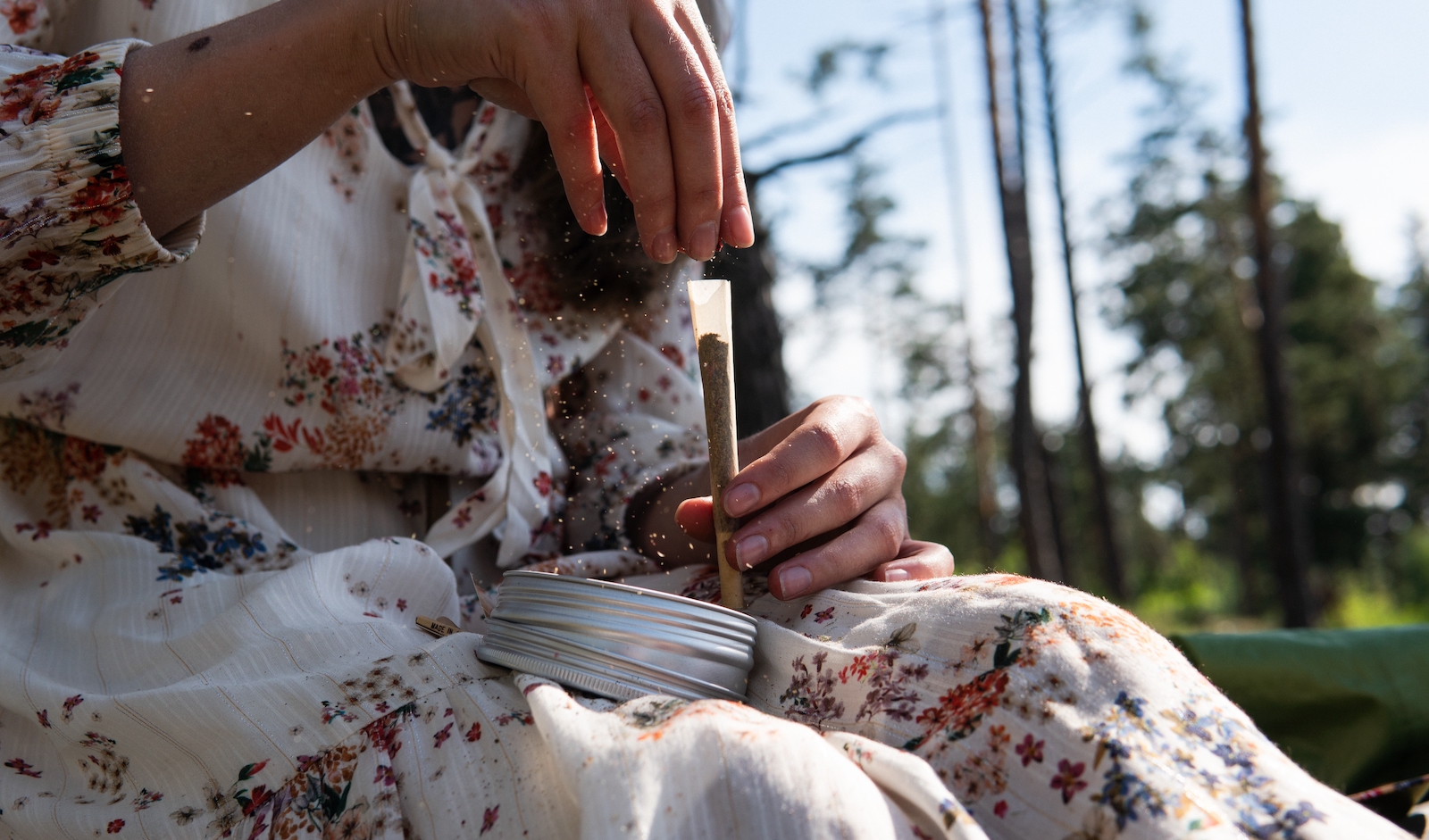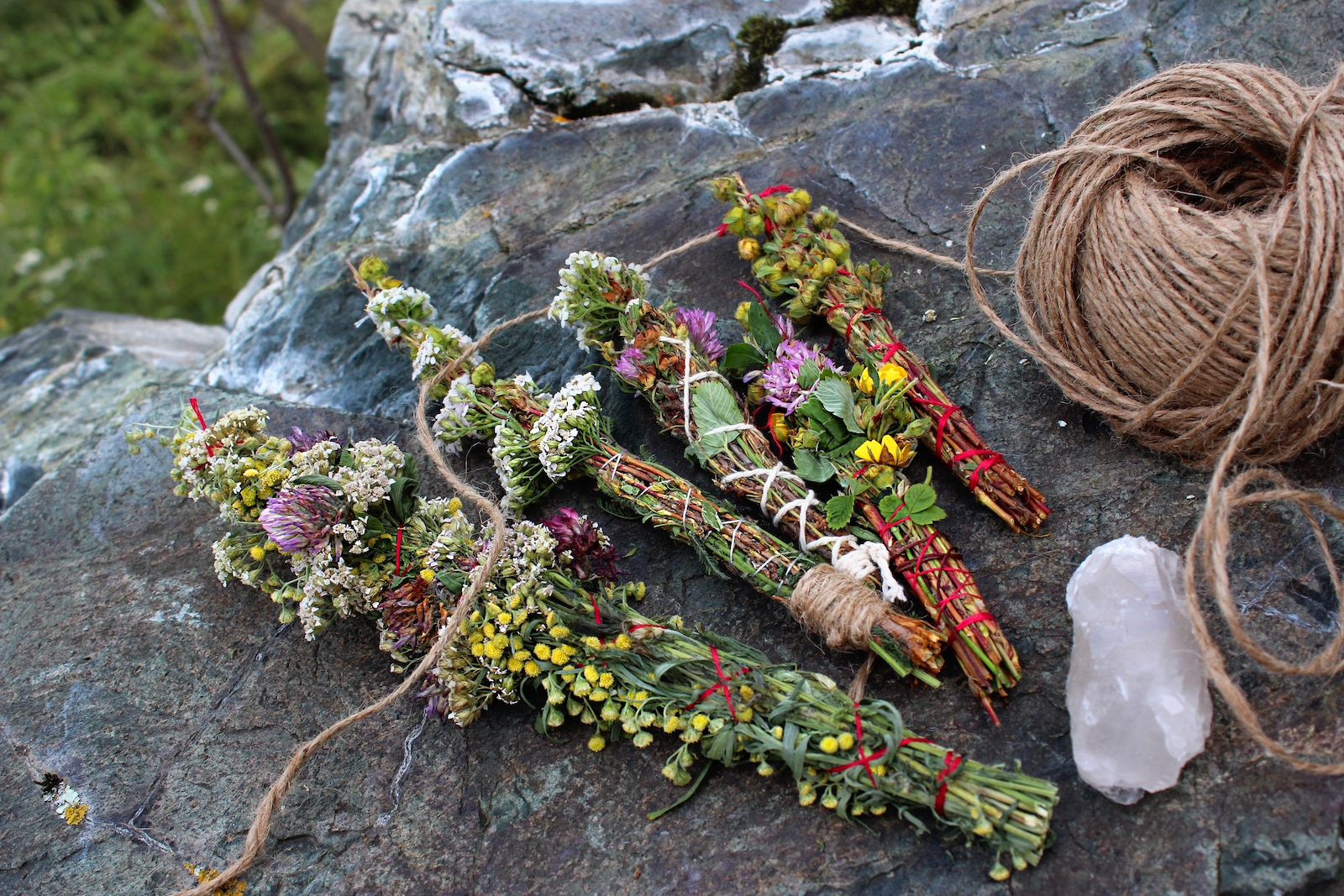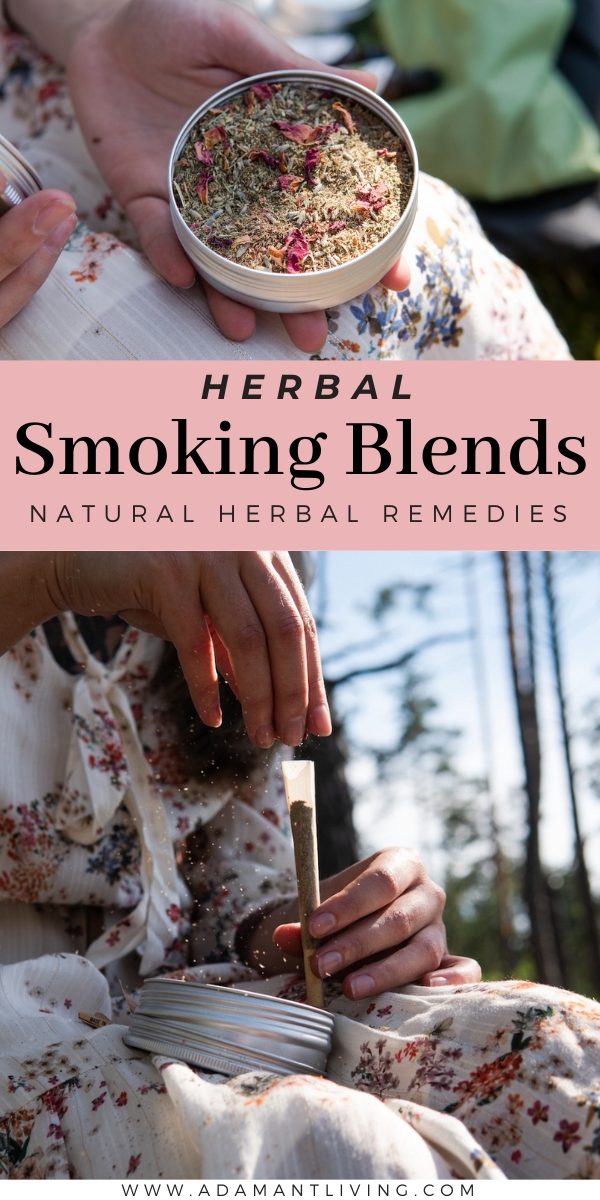Herbal cigarettes were a common way to take your medicine, long before cigarettes became associated with tobacco (and addiction). Learn how to choose herbs for herbal cigarettes, and enjoy this time-honored way to take your medicine.

Herbal Smoking Blends
There are literally dozens of different herbal preparations, from teas to tinctures, to salves, ligaments, and creams.
Herbal smoking blends are just one more way to take your medicine.
Though “smoking herbs” has become associated with one particular herb in our modern culture, historically, herbal cigarettes were used as a form of medicine that can deliver targeted herbal remedies quickly and efficiently.
In this guide, I’m going to cover common, legal, medicinal herbs that are used in smoking blends by herbalists and naturopaths. (There’s already plenty of information out there on smoking that one particular herb, so there’s no need to go into that.)

Making Herbal Cigarettes
What are Herbal Cigarettes?
Herbal cigarettes are a type of cigarette made with herbs and plants, usually without the addition of tobacco. Many Native American cultures have recognized the benefits of smoking medicinal herbs for thousands of years, with smoke being an important component of ritual, ceremony, and prayer.
Historically, the Algonquin word kinnikinnick has referred to traditional Native American herbal smoking mixtures made with uva-ursi as a base herb. The contents of a kinnikinnick mixture vary according to its origin, and are made from a combination of different leaves and barks from plants and trees such as red osier dogwood, laurel, mullein, and huckleberry.
While homemade herbal cigarettes are typically made with dried herbs like lavender, marshmallow leaf, and calendula (among many, many others) — tobacco is sometimes be included in commercially produced herbal cigarettes. Herbal cigarettes with tobacco are often in sold in packs like regular cigarettes, and have very few, if any, medicinal benefits.
When you’re inhaling smoke, no matter the source, your lungs are exposed to carcinogenic compounds. Because hand-rolled herbal cigarettes are nicotine free and used therapeutically (and therefore infrequently), the risk of the herbal cigarettes becoming habit-forming are practically non-existent.
(While forming the herbs into cigarettes is a direct way to smoke herbs, you can also make smudge sticks and herbal incense for a more diffuse remedy that’s just used in a room with you.)

Herbal Smoking Bundles
Why Smoke Herbs?
When herbs are smoked, the goal is to get beneficial plant constituents into the bloodstream as quickly as possible.
Although it might sound contradictory by today’s conventions, one major reason for smoking medicinal herbs is to quell signs of respiratory illness as swiftly as possible. Before the invention of modern cough suppressants, herbs such as marshmallow leaf and mullein were smoked for their fast-acting, anti-cough properties, providing potentially life-saving relief almost instantaneously.
Herbs like lavender and mint are also smoked to induce relaxation and encourage a sense of calm, and can be particularly beneficial if you find yourself suffering from low-level anxiety. Aromatic herbs contribute to
For some people, tobacco-free herbal cigarettes can be a helpful intermediary tool when quitting a smoking habit.
Benefits of Smoking Herbs
There are several benefits to smoking herbs medicinally, the primary reason being rapid absorption into the bloodstream. When herbs are smoked, their medicinal compounds act quickly, because they don’t have to be metabolized (which happens when you ingest herbs via tea or tincture).
Smoking herbs directly targets the lungs, a valuable benefit when you’re inhaling an herb like mullein or coltsfoot, both of which have been used for thousands of years to treat asthma and chest congestion.
This same fast-acting mechanism is also appreciated when you’re smoking herbs which are valued for their calming properties. Smoking hand-rolled peppermint or lemon balm cigarettes is a relaxing experience because of the herbs themselves, and the act of breathing in pleasantly aromatic smoke is soothing in its way.
Taking herbs via smoke inhalation can also be a practical application if someone is unable to keep food down. Certain herbs, like raspberry leaf, will help alleviate feelings of nausea naturally when smoked.
Are Herbal Cigarettes Legal?
Herbal cigarettes are absolutely legal — it’s only when illegal ingredients are introduced to the smoking mix that their contents become legally questionable.
How to Make a Herbal Cigarette
Rolling an herbal cigarette is fairly simple, it just takes a little bit of practice to get the hang of it.
Before you begin, make sure any plant material you plan on using is completely dried before you smoke it. Wet or damp herbs are more likely to harbor mold, which is definitely a substance you don’t want to be inhaling into your lungs.
However, you also don’t want the herbs to be too dry (to the point of feeling crispy) as this can mean you’re dealing with old product and inferior potency. This usually isn’t an issue when you’re drying your own herbs, but it’s something to watch out for if you’re buying pre-dried herbs for smoking. Overly dried smoking material can also increase your chances of accidentally grinding the herbs into too fine a powder, which will cause the cigarette to burn very quickly, leaving an unpleasant residue in your mouth from inhaling powdered herbs.
When it comes to grinding dried herbs for smoking, I use a wooden herb grinder like this one to ensure an even consistency or a mortar and pestle. If you’re feeling patient you can use a pair of kitchen shears or even your fingers to create a fine grind — removing any sticks or seeds that might be in the mix by hand.
If you’re dealing with very dry herbs, take the amount you’re planning on smoking (no more, or else you run the risk of moldy herbs) and spread on a clean tea towel. Mist with water until just damp, and then allow the gently reconstituted herbs to air dry for a couple of hours before smoking.
Rolling papers are very much a personal preference, so I would say use what you like or are familiar with. Rolling papers can be made with wood pulp, hemp, rice paper, and cellulose — my one suggestion would be to buy papers which are certified organic whenever possible. The difference in cost is negligible, and it means the papers are free from bleach and other chemical additives (which is always a good thing but especially so when you’re smoking for an herb for its therapeutic benefits).
To roll an herbal cigarette, place a small amount of dried plant material on a single paper. Carefully roll up, using your fingers to push the bottom part of the paper upwards as you roll up towards the top. Seal and roll between your fingers to ensure an even shape, the contents of the cigarette should be packed fairly tightly to promote an even burn.
If you want to avoid smoking paper, you can also use a small hand pipe — I’m currently loving the gorgeous pieces sold by Sacred Smoke Herbals.
Smokable Herbs
There are literally dozens, if not hundreds, of herbs that were smoked for medicinal purposes. Obviously, the choice of smoking herbs depends on your goals.
This is a list of some of the herbs you can smoke, but it’s not a comprehensive list.
Obviously, I’d suggest you consult your doctor before trying any herbal remedy, and you should be aware that there’s always the danger or allergic reaction or adverse effects.
Calendula
Bright orange calendula flowers are smoked for their mood-boosting benefits and anti-inflammatory compounds. Calendula smoke is described as having a clean, citrusy taste and fragrance — perfect for gaining much-needed mental clarity on those days when your brain feels like it’s in a fog.
Chamomile
Smoking dried chamomile flowers is said to induce a state of relaxation and alleviate symptoms of gas and intestinal distress. Chamomile can be used as a base herb or as a therapeutic herb, depending on your tolerance to its effects, and can also be smoked in place of tobacco if you’re trying to quit smoking regular cigarettes.
Lavender
The soothing aroma of lavender is enhanced when it’s burning, which makes it an ideal herb for smoking when you’re wanting to relax and replenish (it’s also a wonderful addition to herbal smoking mixtures). Lavender can also be smoked for its ability to fend off insomnia, to relieve headache pain and muscle soreness, and to ease discomfort resulting from intestinal gas.
Marshmallow
When dried marshmallow leaf is smoked it has the potential to offer rapid relief from chest tightness, coughing, and sore throat. Marshmallow is used in Ayurvedic medicine to increase kapha and reduce vata, which means to increase wetness in the body while reducing dryness.
Marshmallow smoke is known for its distinctive sweetness, and is also enjoyed for its calming effects. Marshmallow leaf is an ideal choice for a base herb when making your own blends and can even be mixed with tobacco if you’re in the process of trying to ween yourself off tobacco.
Mint
Whether you prefer peppermint or spearmint (or some other kind of mint), smoking mint is thought to promote healthy blood circulation while calming the nerves. The inhalation of mint smoke to treat respiratory issues and chest congestion by clearing the lungs is a time-honored remedy.
Mint can also be added to herbal smoking mixtures in smaller amounts. Peppermint, especially, has a clean menthol taste that leaves a lingering sweetness on the breath after it’s been smoked.
Mullein
Mullein, also called a velvet or wooly plant, was first brought over to North America by early European settlers. Mullein is an expectorant, which means it breaks down phlegm in the lungs and induces productive coughing.
Mullein is very similar in texture to tobacco, but doesn’t contain any habit-forming nicotine. The smoke from dried mullein is described as being very light and almost tasteless, almost as if you weren’t smoking anything at all. For this reason, many people who enjoy herbal cigarettes like to include mullein as a base herb when making their own smoking blends.
Mugwort
Mugwort has traditionally been smoked for its mild hallucinogenic properties during ceremonies and prayer. When mugwort is smoked it helps relax the body and induce a calm mood; it’s also said to improve dream recollection when taken before sleep.
Mugwort has a variety of therapeutic properties, and is used to relieve symptoms of a wide range of ailments (including asthma, chronic pain, and menstrual pain).
Raspberry Leaf
When smoked, the natural muscle relaxing-effects of red raspberry leaf can do wonders for relieving pain associated with menstrual cramping. Smoking raspberry leaf is also thought to neutralize the toxic effects of tobacco use and increase feelings of well being.
Dried red raspberry leaf is very fluffy, and makes a good neutral base herb for homemade smoke blends.
Rose Petals
With their lovely floral aroma, dried rose petals are smoked for their ability to calm and lift low moods — you might notice subtle feelings of euphoria after smoking them. Because of their mild psychoactive effects and sweet flavor, rose petals are a great addition to smoking blends which are made to combat anxiety and mild depression.
Rosemary
Rosemary is well-known for its anti-microbial properties, and when smoked, it can alleviate symptoms of respiratory illness. The taste and smell of dried rosemary is very pronounced, and the herb should be added to smoking blends judiciously.
Thyme
Thyme is another herb that helps to relieve coughing and chest congestion when smoked. Even a pinch of thyme will add sweet, woody notes to the taste and smell of herbal blends.
Uva Ursi
Uva Ursi, also known as a bearberry plant or kinnikinnick, has historically been used by Native Americans to promote kidney and liver health and for the herb’s anti-inflammatory properties. Uva ursi is almost always mixed with other smokeable herbs, as well as with tobacco.
Herbal Smoking Blends
While you certainly can smoke individual herbs, smoking herbs are often blended to create mixes with specific targeted goals in mind.
When making your own blend, it can be helpful to think of your herbal mixture in three parts.
The first component, which will act as the base of your blend, should make up about 50 percent of the final mixture. Choose neutral herbs like mullein, raspberry leaf, or damiana — or a blend of two or all three herbs.
The second part of the mixture, which consists of the herb being used for its medicinal properties, should make up another 30 percent (approximately) of the blend. Again, your choice of plant material here will depend on the desired effect of the herb.
The third and final part of rounding out a homemade herbal smoking blend involves choosing a dried herb that adds flavor to the finished product (in other words, an herb that makes the smoking experience pleasurable as well as therapeutic).
Put into exact measurements, an ideal ratio for an herbal smoking blend would look like this:
- 2 tablespoons base herbs
- 1 tablespoon therapeutic herbs
- 1 1/2 teaspoons flavoring herbs
If you’re interested in trying out different smoking blends but don’t want to make your own, you can purchase pre-mixed smoking blends from reputable online shops like Mountain Rose Herbs and Sacred Smoke Herbals.
Anxiety
- Red raspberry leaf (as a base)
- Mugwort (as a therapeutic herb)
- Rose petals (a generous pinch)
Better Sleep
- Mugwort (as a base)
- Chamomile (as a therapeutic herb)
- Lavender (a generous pinch)
Respiratory Congestion
- Marshmallow leaf (as a base)
- Mint (as a therapeutic herb)
- Rosemary (a generous pinch)
For Mental Clarity
- Uva Ursi (as a base)
- Calendula blossoms (as a therapeutic herb)
- Peppermint (a generous pinch)
Other Ways to Use Herbal Smoke
Some herbs, such as mint, sage, and lavender, contain oils which naturally repel insects. You can easily make your own herbal smoke insect repellant by putting together “bug bomb” bundles. You can burn them while you’re sitting outside at night on the porch, or toss a couple of them onto the fire for a naturally bug-free environment.
Herbal smudge sticks are a sacred component of some Native American ceremonies, and are used for many reasons, including (but not limited to) clearing away negative energy in a space and bathing away stress. The history and practice around the use smudge sticks is fascinating and highly worth reading up on; you can find instructions for making your own herbal smudge sticks here.

Hi. Thank you for this awesome information. Very interesting and I would love to read more .🤗.
Thanks again,
Michelle
This is wonderful I’m really pleased! Great information